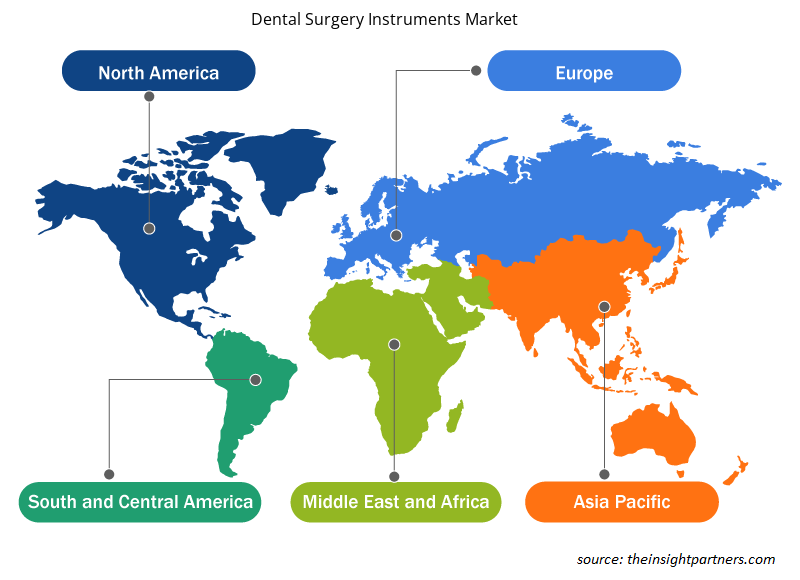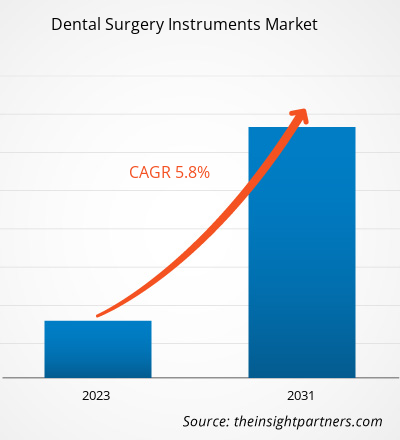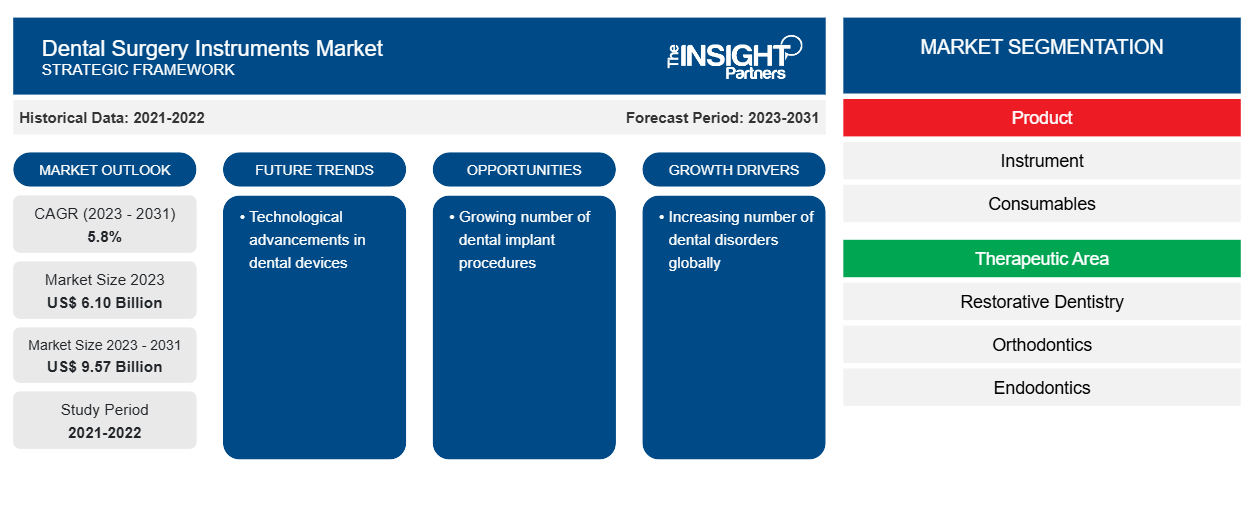Si prevede che la dimensione del mercato degli strumenti per chirurgia dentale raggiungerà i 9,57 miliardi di dollari entro il 2031, rispetto ai 6,10 miliardi di dollari del 2023. Si prevede che il mercato registrerà un CAGR del 5,8% nel 2023-2031. La crescente prevalenza di infezioni dentali, i progressi tecnologici nel settore dentale e il crescente numero di procedure odontoiatriche rimarranno probabilmente le principali tendenze del mercato degli strumenti per chirurgia dentale.CAGR of 5.8% in 2023–2031. The increasing prevalence of dental infection, technological advancements in the dental industry, and the rising number of dental procedures are likely to remain key Dental Surgery Instruments market trends.
Analisi di mercato degli strumenti per la chirurgia dentale
Il crescente peso delle malattie dentali come carie, malattia parodontale, cancro orale, alitosi e carie dentale a livello globale sta aumentando la crescita del mercato. Ad esempio, le malattie orali colpiscono circa 3,5 miliardi di persone a livello globale. Le malattie orali rappresentano un importante peso per la salute sia nei paesi sviluppati che in via di sviluppo e colpiscono le persone per tutta la loro vita, causando dolore, disagio, deturpazione e persino la morte. Pertanto, si prevede che l'enorme peso delle malattie dentali aumenterà la domanda complessiva per il suo trattamento e gli interventi chirurgici, aumentando così il mercato degli strumenti chirurgici dentali nel periodo di previsione.
Panoramica del mercato degli strumenti per la chirurgia dentale
Il Nord America è il mercato più grande per la crescita del mercato degli strumenti per la chirurgia dentale, con gli Stati Uniti che detengono la quota di mercato maggiore, seguiti dal Canada. Si prevede che fattori come la crescente prevalenza di malattie dentali, le iniziative governative per aiutare le persone con cure odontoiatriche e una maggiore consapevolezza tra la popolazione stimoleranno ulteriormente il mercato complessivo degli strumenti per la chirurgia dentale nordamericana. Ad esempio, nel 2021, secondo i dati recuperati dal Center for Disease Control, all'età di 8 anni, oltre la metà dei bambini (52%) ha avuto una carie nei denti primari (da latte) negli Stati Uniti. Allo stesso modo, secondo il National Institute of Dental and Craniofacial Research nel 2022, la carie colpisce il 90% della popolazione adulta di età compresa tra 20 e 64 anni e la malattia gengivale colpisce quasi il 50% degli adulti di età compresa tra 45 e 64 anni, che rimangono due delle malattie orali più diffuse negli Stati Uniti. Quindi, la crescente popolazione adulta che soffre di malattie orali richiederà cure e interventi chirurgici odontoiatrici che a loro volta stanno guidando il mercato degli strumenti per la chirurgia dentale nordamericana.Craniofacial Research in 2022, tooth decay affects 90% of the adult population aged 20 to 64 years, and gum disease, affects almost 50% of adults aged 45 to 64 years, which remains two of the most prevalent oral diseases in the US. Hence, the rising adult population suffering from oral disease will demand dental treatment and surgery which in turn is driving the North American Dental Surgery Instruments market.
Personalizza questo report in base alle tue esigenze
Riceverai la personalizzazione gratuita di qualsiasi report, comprese parti di questo report, o analisi a livello nazionale, pacchetto dati Excel, oltre a usufruire di grandi offerte e sconti per start-up e università
-
Scopri le principali tendenze di mercato in questo rapporto.Questo campione GRATUITO includerà analisi di dati che spaziano dalle tendenze di mercato alle stime e alle previsioni.
Driver e opportunità di mercato degli strumenti per la chirurgia dentale
La crescente prevalenza di disturbi dentali richiede un sistema di strumenti per la chirurgia dentale che favorisce il mercato
Il crescente peso delle malattie dentali e la sua crescente prevalenza stanno guidando la crescita del mercato. Ad esempio, secondo l'Organizzazione mondiale della sanità (OMS), si stima che le malattie orali colpiscano circa 3,5 miliardi di persone in tutto il mondo e che anche la grave malattia parodontale (gengivale), che può causare la perdita dei denti, sia molto comune, con quasi il 14% della popolazione mondiale colpita. Inoltre, l'iniziativa governativa intrapresa è un altro fattore nella crescita del mercato. Paesi come la Spagna e il suo governo hanno intrapreso iniziative per rendere l'assistenza odontoiatrica accessibile a una larga parte della popolazione. Sono inoltre in corso investimenti per espandere la copertura odontoiatrica. Ad esempio, a febbraio 2021, il governo spagnolo ha stanziato 49 milioni di euro per espandere la copertura dell'assistenza odontoiatrica.
Progressi tecnologici negli strumenti di chirurgia dentale: un'opportunità nel mercato degli strumenti di chirurgia dentale
I produttori e i professionisti del settore dentale utilizzano la stampa 3D per diverse applicazioni cliniche e scopi di ricerca. La produzione di strati additivi nella stampa 3D consente ai dentisti di realizzare dispositivi medici personalizzati, nonostante forme complesse, sistemi porosi e sistemi di assistenza interna, cosa che non è possibile con i dispositivi dentali tradizionali. La tecnologia viene utilizzata per realizzare dispositivi chirurgici monouso e riutilizzabili personalizzati. La tecnologia aiuta inoltre i professionisti del settore dentale a fornire numerosi impianti dentali personalizzati , tra cui allineatori trasparenti, corone, ponti e contenitori. Le scansioni 3D della bocca del paziente assicurano un'elevata precisione e personalizzazione degli impianti dentali, migliorandone la corrispondenza, il comfort e la semplicità della procedura chirurgica. Si prevede che l'avvento di tali tecnologie stimolerà il mercato complessivo degli strumenti per la chirurgia dentale.customizability of dental implants, improving their match, comfort, and simplicity of surgical procedure. The advent of such technologies is expected to boost the overall dental surgery instrument market.
Analisi della segmentazione del rapporto di mercato degli strumenti per chirurgia dentale
I segmenti chiave che hanno contribuito alla derivazione dell'analisi di mercato degli strumenti per chirurgia dentale sono i servizi, i fornitori di servizi e gli utenti finali.
- In base al prodotto, il mercato degli strumenti per chirurgia dentale è segmentato in strumenti e materiali di consumo. Gli strumenti hanno detenuto una quota di mercato maggiore nel 2023. La quota maggiore può essere attribuita alla crescente adozione di strumenti per procedure chirurgiche dentali.
- Per area terapeutica, il mercato è segmentato in odontoiatria restaurativa, ortodonzia, endodonzia e altre aree terapeutiche. Il segmento dell'odontoiatria restaurativa ha detenuto la quota maggiore del mercato nel 2023.
- In base all'utente finale, il mercato è segmentato in ospedali e cliniche. Il segmento delle cliniche ha detenuto la quota di mercato maggiore nell'anno 2023. La crescente accettazione di strumenti chirurgici avanzati e il numero di cliniche odontoiatriche nei paesi emergenti e sviluppati sono i fattori che aumentano la domanda di strumenti di chirurgia odontoiatrica nelle cliniche.
Analisi della quota di mercato degli strumenti per chirurgia dentale per area geografica
L'ambito geografico del rapporto sul mercato degli strumenti per chirurgia dentale è suddiviso principalmente in cinque regioni: Nord America, Asia Pacifico, Europa, Medio Oriente e Africa e Sud America/Sud e Centro America.
Il Nord America ha dominato il mercato degli strumenti per la chirurgia dentale. La crescita del mercato può essere attribuita alla crescente incidenza globale delle malattie dentali a livello globale, all'espansione della popolazione geriatrica e alla necessità di strumenti dentali per l'odontoiatria estetica che sta guidando il mercato degli strumenti per la chirurgia dentale nordamericana. Inoltre, si prevede che la domanda di strumenti per la chirurgia dentale e la sua crescente adozione nei prossimi anni a causa del ripetuto consumo di materiali di consumo da parte di ospedali, dentisti e cliniche odontoiatriche stimoleranno ulteriormente il mercato degli strumenti per la chirurgia dentale nei paesi nordamericani.
Approfondimenti regionali sul mercato degli strumenti per la chirurgia dentale
Le tendenze regionali e i fattori che influenzano il mercato degli strumenti per chirurgia dentale durante il periodo di previsione sono stati ampiamente spiegati dagli analisti di Insight Partners. Questa sezione discute anche i segmenti e la geografia del mercato degli strumenti per chirurgia dentale in Nord America, Europa, Asia Pacifico, Medio Oriente e Africa e America centrale e meridionale.

- Ottieni i dati specifici regionali per il mercato degli strumenti per chirurgia dentale
Ambito del rapporto di mercato sugli strumenti per chirurgia dentale
| Attributo del report | Dettagli |
|---|---|
| Dimensioni del mercato nel 2023 | 6,10 miliardi di dollari USA |
| Dimensioni del mercato entro il 2031 | 9,57 miliardi di dollari USA |
| CAGR globale (2023-2031) | 5,8% |
| Dati storici | 2021-2022 |
| Periodo di previsione | 2023-2031 |
| Segmenti coperti |
Per Prodotto
|
| Regioni e Paesi coperti |
America del Nord
|
| Leader di mercato e profili aziendali chiave |
|
Densità degli attori del mercato: comprendere il suo impatto sulle dinamiche aziendali
Il mercato degli strumenti per chirurgia dentale sta crescendo rapidamente, spinto dalla crescente domanda degli utenti finali dovuta a fattori quali l'evoluzione delle preferenze dei consumatori, i progressi tecnologici e una maggiore consapevolezza dei benefici del prodotto. Con l'aumento della domanda, le aziende stanno ampliando le loro offerte, innovando per soddisfare le esigenze dei consumatori e capitalizzando sulle tendenze emergenti, il che alimenta ulteriormente la crescita del mercato.
La densità degli operatori di mercato si riferisce alla distribuzione di aziende o società che operano in un particolare mercato o settore. Indica quanti concorrenti (operatori di mercato) sono presenti in un dato spazio di mercato in relazione alle sue dimensioni o al valore di mercato totale.
Le principali aziende che operano nel mercato degli strumenti per chirurgia dentale sono:
- Dentsply Sirona
- 3 milioni
- Danaher
- Società a responsabilità limitata Coltene Holdings AG
- Brasseler USA
- Integra Scienze della vita
Disclaimer : le aziende elencate sopra non sono classificate secondo un ordine particolare.

- Ottieni la panoramica dei principali attori del mercato degli strumenti per chirurgia dentale
Notizie di mercato e sviluppi recenti degli strumenti per la chirurgia dentale
Il mercato degli strumenti per chirurgia dentale viene valutato raccogliendo dati qualitativi e quantitativi post-ricerca primaria e secondaria, che includono importanti pubblicazioni aziendali, dati di associazioni e database. Di seguito è riportato un elenco degli sviluppi nel mercato degli strumenti per chirurgia dentale:
- J. Morita Corp. ha acquisito l'attività dello stabilimento Dentsply Sirona Nasu in Giappone, che produce prodotti ortodontici e altri prodotti correlati all'odontoiatria. Tale acquisizione aumenterebbe la crescita del mercato degli strumenti per la chirurgia dentale nel prossimo periodo. (Fonte: J Morita Corporation, comunicato stampa/sito Web aziendale/newsletter, aprile 2021)
- Henry Schein, Inc., il più grande fornitore al mondo di soluzioni sanitarie per odontoiatri e medici ambulatoriali, ha annunciato di aver completato l'acquisizione di Condor Dental Research Company SA (Condor Dental), una società di distribuzione odontoiatrica al servizio di odontoiatri generici, specialisti e laboratori in Svizzera. (Fonte: J Morita Corporation, comunicato stampa/sito Web aziendale/newsletter, giugno 2022)
Copertura e risultati del rapporto di mercato sugli strumenti per la chirurgia dentale
Il rapporto "Dimensioni e previsioni del mercato degli strumenti per chirurgia dentale (2021-2031)" fornisce un'analisi dettagliata del mercato che copre le seguenti aree:
- Dimensioni e previsioni del mercato a livello globale, regionale e nazionale per tutti i segmenti di mercato chiave coperti dall'ambito
- Dinamiche di mercato come fattori trainanti, vincoli e opportunità chiave
- Principali tendenze future
- Analisi dettagliata delle cinque forze PEST/Porter e SWOT
- Analisi di mercato globale e regionale che copre le principali tendenze di mercato, i principali attori, le normative e gli sviluppi recenti del mercato
- Analisi del panorama industriale e della concorrenza che copre la concentrazione del mercato, l'analisi della mappa di calore, i principali attori e gli sviluppi recenti
- Profili aziendali dettagliati
- Analisi storica (2 anni), anno base, previsione (7 anni) con CAGR
- Analisi PEST e SWOT
- Valore/volume delle dimensioni del mercato - Globale, Regionale, Nazionale
- Industria e panorama competitivo
- Set di dati Excel
Report recenti
Rapporti correlati
Testimonianze
Motivo dell'acquisto
- Processo decisionale informato
- Comprensione delle dinamiche di mercato
- Analisi competitiva
- Analisi dei clienti
- Previsioni di mercato
- Mitigazione del rischio
- Pianificazione strategica
- Giustificazione degli investimenti
- Identificazione dei mercati emergenti
- Miglioramento delle strategie di marketing
- Aumento dell'efficienza operativa
- Allineamento alle tendenze normative























 Ottieni un campione gratuito per - Mercato degli strumenti per la chirurgia dentale
Ottieni un campione gratuito per - Mercato degli strumenti per la chirurgia dentale